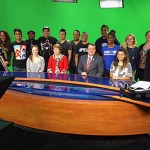Associate Professor Michael Cheers, School of Journalism and Mass Communications, is part of a team leading an immersive journalism program for 25 high school and college students this summer in Washington, D.C. During “Newsroom U: A White House Student Press Briefing and Multimedia Weekend,” students will focus on the election year issues affecting Washington metro-area millennials and post stories on an interactive website that will also be shared with other media outlets, including USA Today. George Washington University School of Media and Public Affairs and the University of Oregon School of Journalism and Communication are also institutional sponsors.
Don Beall Dean of Engineering Andrew Hsu will become the University of Toledo’s provost and executive vice president for Academic Affairs on July 1. Hsu is no stranger to Ohio. From 2010 to 2013, he held the position of associate vice president for research at Wright State University in Dayton and, earlier in his career, worked as a senior research engineer at the NASA Glenn Research Center in Cleveland.
College of Social Science Dean Walt Jacobs revisited his first published article in February, a piece about Ralph Ellison’s Invisible Man, when he interacted with AP English students who were studying the text at their high school in Iowa. The students read the book and Jacobs’ article, then posted questions to a blog to which Jacobs responded. He has coordinated with the AP English teacher in the past on a similar activity. “It was a lot of fun, and the students learned a lot, I hope,” Jacobs said, via his own blog.
Earlier this month, Professor Anne Lawrence, Department of Organization and Management, gave a public lecture at the University of Cape Coast on the topic “Social, Ethical and Environmental Responsibility in the Global Supply Chain,” stressing the need for multinational companies operating in Ghana and other regions of Africa to protect natural resources.
Lecturer Marc Privitera, Department of Biomedical, Chemical and Materials Engineering, was appointed to the technical advisory board of Canadian International Minerals. Principal engineer and co-founder of PreProcess in San Ramon, he holds numerous U.S. patents in the area of chemical process design.
School of Information Lecturer Scott Walker, finalist for the dean of libraries at the University of Massachusetts Amherst, gave a presentation to that campus community on March 8. His topic: “Vision of Academic Research Libraries for the Next Five Years.”
Professor Mary Warner, Department of English and co-editor of Teaching Writing Grades 7-12 in an Era of Assessment: Passion and Practice (Pearson Academic Computing, 2013), was interviewed by LifeZette.com about the importance of encouraging kids to read books in our “shorter, quicker” world of texts and tablets.
Project Director James Wayman, Information Technology Services, was interviewed by livescience.com about Amazon’s pending patent to have customers pay for purchases by means of a facial recognition system that would, in theory, stop fraud. As reported, Wayman pointed out that governmental attempts to create security systems based on facial recognition have run into difficulties because “faces are not hard to fake.” In May, Wayman will lead a session on biometrics at the 2016 IEE International Symposium on Technologies for Homeland Security in Massachusetts.




